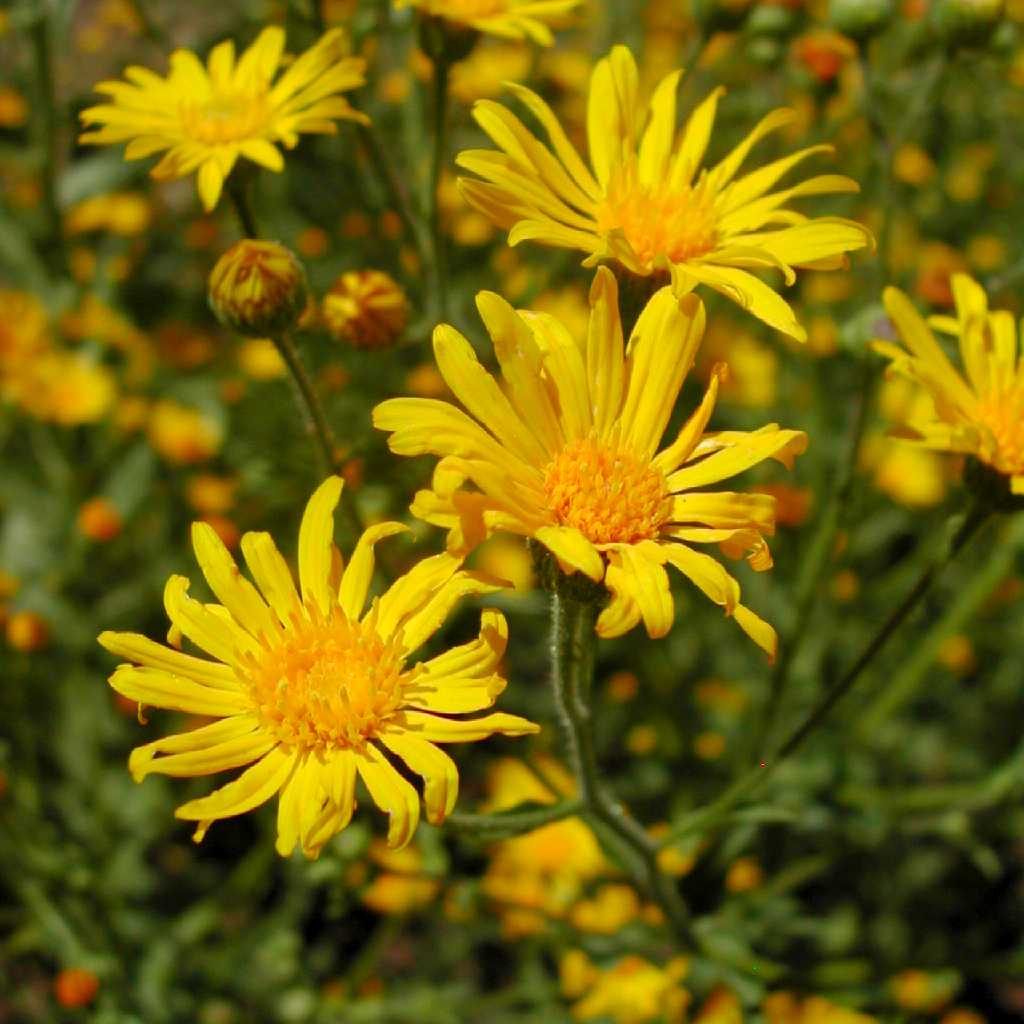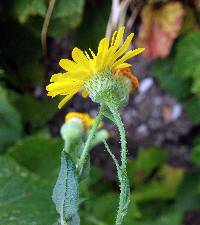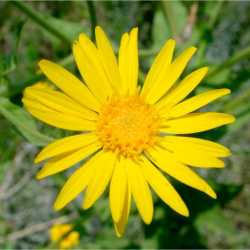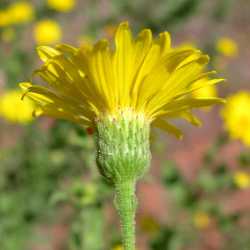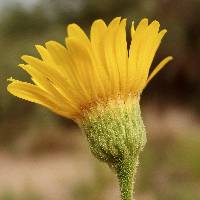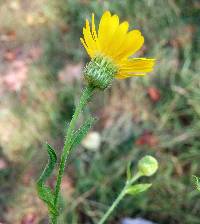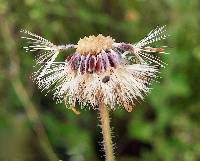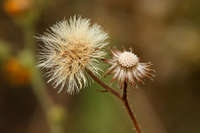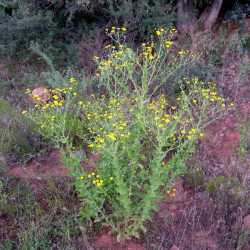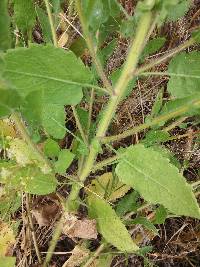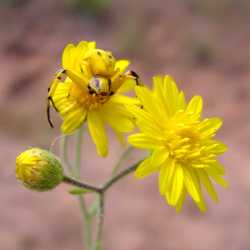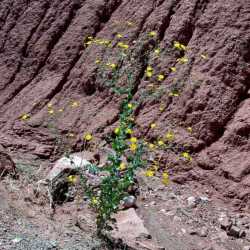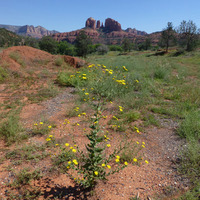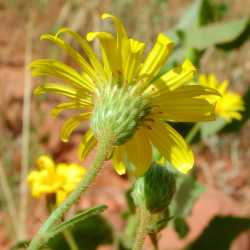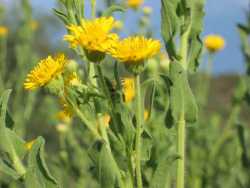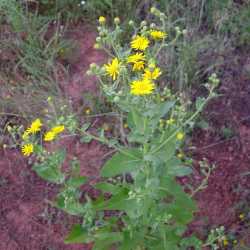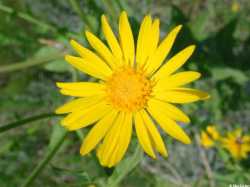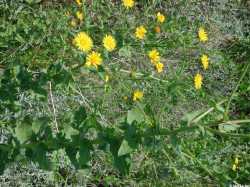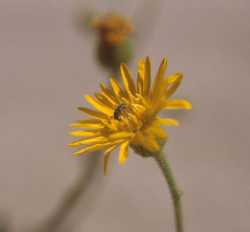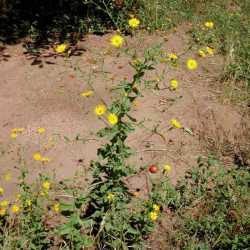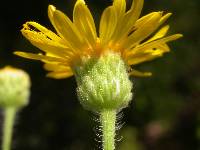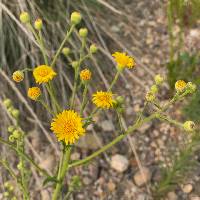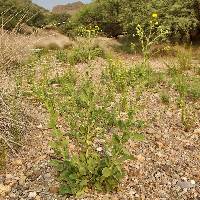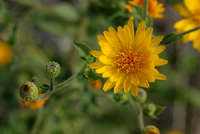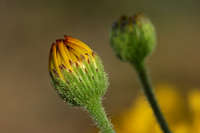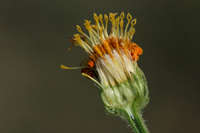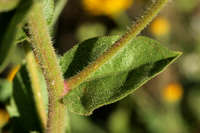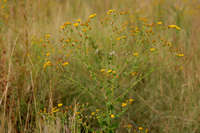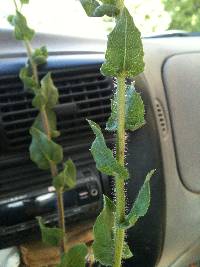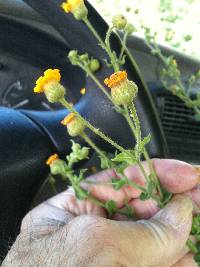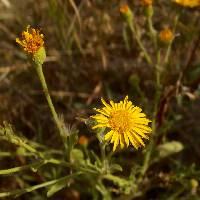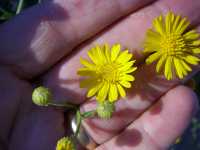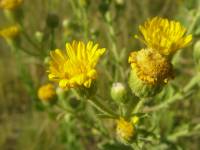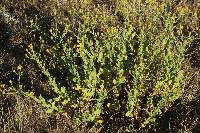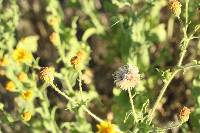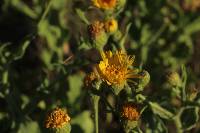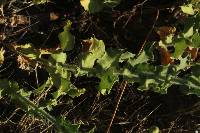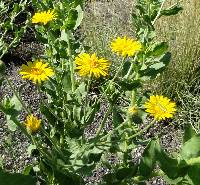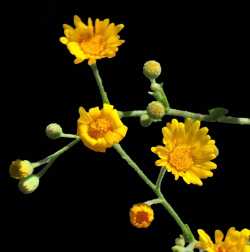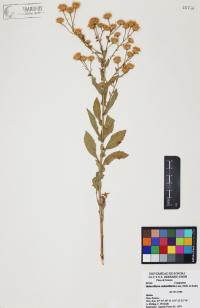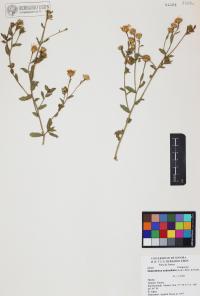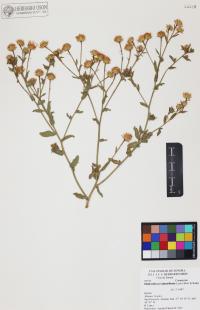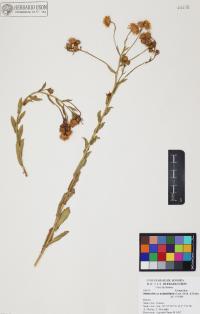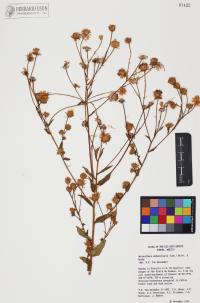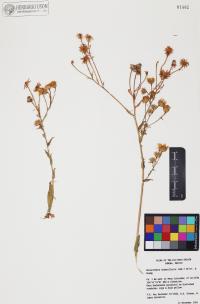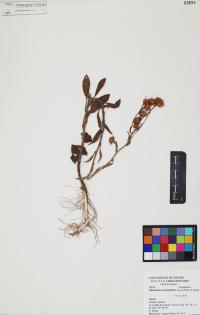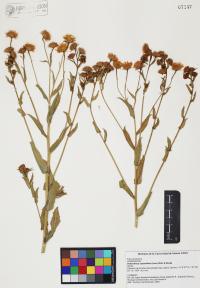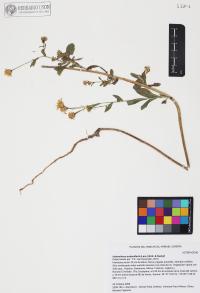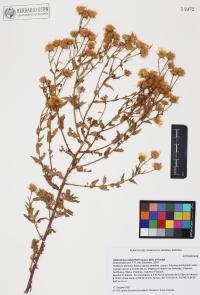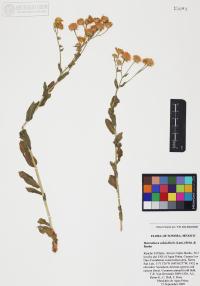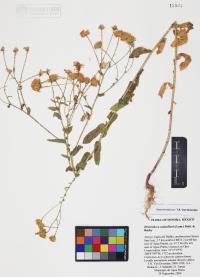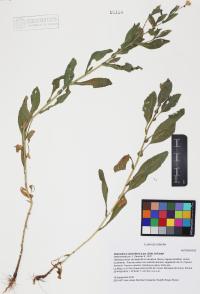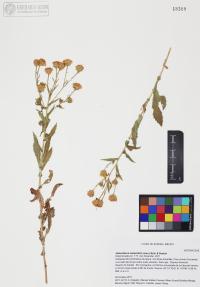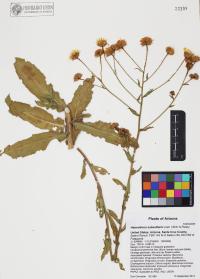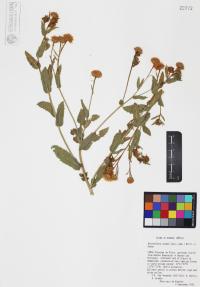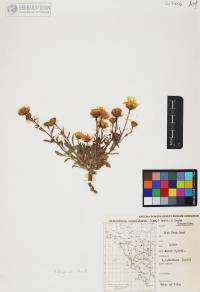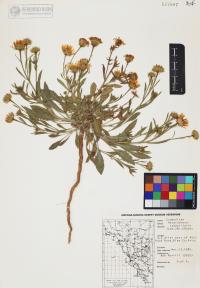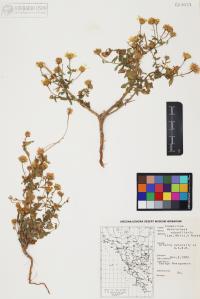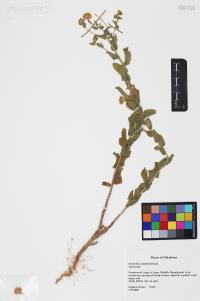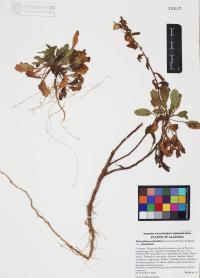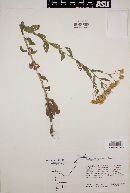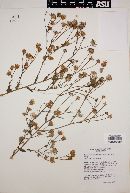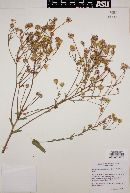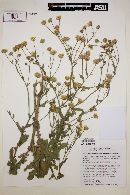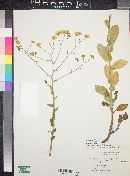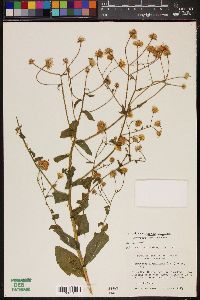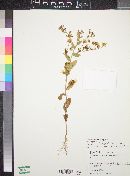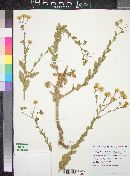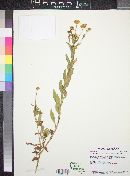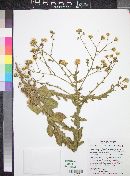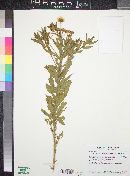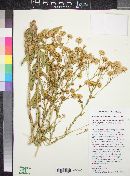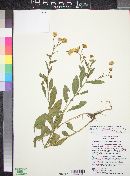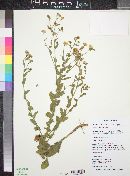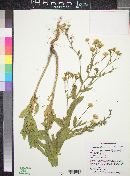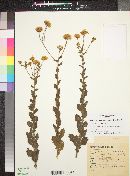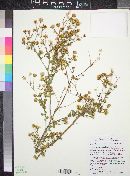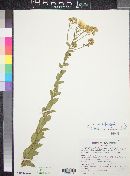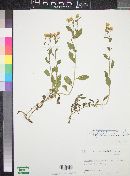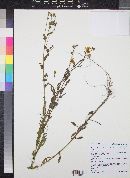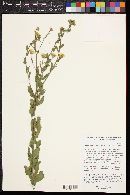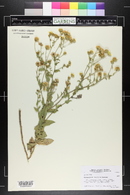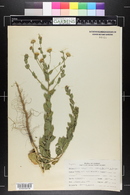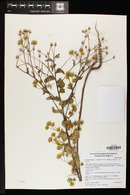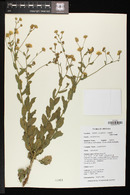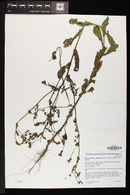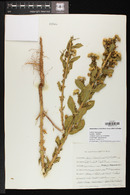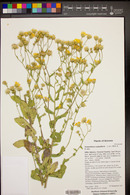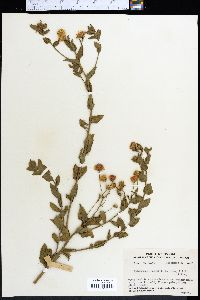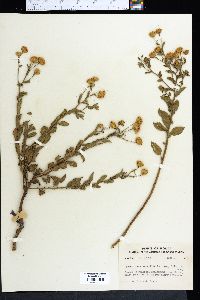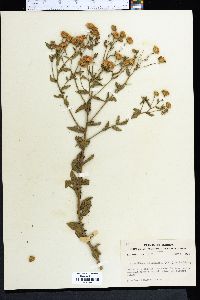Heterotheca subaxillaris
|
|
|
|
Family: Asteraceae
Camphorweed, more...telegraph weed, golden-aster (es: árnica)
[Chrysopsis scabra (Pursh) Ell., moreHeterotheca lamarckii Cass., Heterotheca latifolia Buckl., Heterotheca latifolia var. arkansana Wagenkn., Heterotheca latifolia var. macgregoris Wagenkn., Heterotheca psammophila Wagenkn., Heterotheca scabra (Pursh) DC., Heterotheca subaxillaris var. latifolia (Buckl.) Gandhi & Thomas, Heterotheca subaxillaris var. petiolaris Benke, Heterotheca subaxillaris var. procumbens Wagenkn., Heterotheca subaxillaris var. psammophila (Wagenkn.) Gandhi, Heterotheca subaxillaris var. subaxillaris] |
Annuals or biennials, 10-200 cm (aromatic); taprooted (rarely perennating in south from proximal stem nodes). Stems 1-4+, procumbent to erect (sometimes reddish brown, proximal to distal branches well developed in larger plants), sparsely to densely hispido-strigose, sparsely to densely stipitate-glandular. Leaves: basal and proximal rarely persisting to flowering, sometimes present and withered, brown to black; basal to mid cauline petiolate (petioles 10-40 mm, bases auriculate-clasping), blades ovate to elliptic or lanceolate, 10-70 × 6-55 mm, bases cuneate to attenuate, margins flat or undulate, coarsely serrate or entire, basally long-ciliate, apices acute, faces moderately hispido-scabrous; distal sessile, blades ovate to lanceolate, 10-90 × 2-20 mm, reduced distally, bases often becoming cordate distally, subclasping or not clasping, margins entire, faces sparsely to moderately hispido-strigose, sparsely to densely stipitate-glandular. Heads 3-180+ in corymbo-paniculiform arrays, sometimes becoming profusely branched (loosely paniculiform or broadly corymbiform in larger plants), branches ascending to spreading. Peduncles 2-35 mm, sparsely to densely hispido-strigose, moderately to densely stipitate-glandular; bracts 0-4, proximal leaflike, ovate to lanceolate, reduced distally and becoming linear, faces sparsely to moderately hispido-strigose, sparsely to densely stipitate-glandular. Involucres hemispheric to campanulate, 4-8(-10) mm. Phyllaries in 4-6 series, lanceolate, sometimes strongly unequal, margins scarious and distally strigoso-ciliate, faces sparsely to densely stipitate-glandular, with 0-28 coarse, scabro-strigose hairs distally. Ray florets 15-35; laminae 3-7(-9) × 1-2 mm. Disc florets 25-60; corollas weakly ampliate, 2-9 mm, proximal throats glabrous to sparsely short-strigose, lobes 0.5-0.7 mm, glabrous. Cypselae dimorphic, obconic, ribs 2-3, (ray) triangular in cross section, 1.5-2.5 mm, faces glabrous to slightly strigose, (disc) laterally compressed, 2-4 mm, faces moderately to densely strigose; pappi 0 (ray) or (disc) tan to rust, outer of linear to triangular scales 0.25-0.6 mm, inner of 25-45 bristles 4-9 mm, longest weakly clavate. 2n = 18. Heterotheca subaxillaris is a very weedy, morphologically variable species that has been treated as three species (B. L. Wagenknecht 1960; V. L. Harms 1965, 1970; J. C. Semple 1996) or as a single polymorphic species (G. L. Nesom 1990e). Harms (1965) acknowledged the difficulty in finding consistent characters to separate plants on a geographic basis, as did Nesom (1990e). Harms (1970) noted that H. psammophila and H. latifolia are probably conspecific. It seems best to treat the complex as a single polymorphic species. In historic times, human-assisted dispersal of possibly once distinct races has likely resulted in blurring of such distinctions with one exception. Plants of the outer coastal plain from Texas to North Carolina usually have a cluster of coarse hairs near the tip of phyllaries, at least in summer and fall-blooming plants.
FNA 2006, Wiggins 1964, Kearney and Peebles 1969 Duration: Annual Nativity: Native Lifeform: Forb/Herb General: Erect annual to biennial herb 40-150 cm tall with striate and short-hirsute stems, moderately branched above. Leaves: Ovate-lanceolate to somewhat lyrate in outline, .8-3.5 cm wide, 2.5-10 cm long, at least upper cordate-clasping, serrate-dentate, acute to obtuse and apiculate at apex, short hirsute-scabrous on both sides. Flowers: Heads corymbosely or broadly paniculately arranged, 6-8 mm high, 10-18 mm wide at anthesis; involucral bracts in several series, lance-linear to subulate, rather rigid, outer ones acute and apiculate, innermost attenuate and scraggly brush of spreading and ascending hairs on terminal part, pale greenish to stramineous below, tips often brownish or reddish; ray flowers 30-50, ligules about 5 mm long, 1 mm wide, yellowish but soon turning brown; corollas 4-5 mm long. Fruits: Cypselae of ray flowers about 3 mm long, glabrous, epappose; cypselae of disk flowers about as long as ray achenes but more slender, densely silky-villous; pappus bristles reddish-brown, longer inner ones about 15 mm long. Ecology: Found in streams, ditches, fence-rows, and in disturbed soils; 1,000-5,500 ft (305-1676 m); flowers August-November. Distribution: Southern half of the US, from CA and NV, east to NY; south to c MEX. Notes: An erect annual that can be tall in the right conditions and has sticky-glandular foliage, clasping leaves and showy heads with yellow rays and disks. Sometimes known as camphor-weed because of its odor. Ethnobotany: Unknown for this species, other species in this genera have medicinal, poisonous, and as a dermatological aid. Etymology: Heterotheca is from Greek heteros, different, and theke, ovary for the different achenes, while subaxillaris means below the axil. Synonyms: Chrysopsis scabra, Heterotheca lamarckii, H. latifolia, H. psammophila, H. scabra Editor: SBuckley 2010, FSCoburn 2014 Taprooted, weedy annual or biennial 2-25 dm, erect or in some habitats low and spreading, glandular, especially above, and spreading- hairy; lvs ovate or oblong, dentate or subentire, the lower ones petiolate (some with a stipule-like basal expansion of the petiole), deciduous, the middle and upper sessile and clasping; invol 6-8 mm, its bracts finely glandular, and usually slightly hairy at the tip; 2n=18. Dry, often sandy places; Del. to Fla., w. to Kans. and Mex., and adventive n. to L.I. July-Sept. Gleason, Henry A. & Cronquist, Arthur J. 1991. Manual of vascular plants of northeastern United States and adjacent Canada. lxxv + 910 pp. ©The New York Botanical Garden. All rights reserved. Used by permission. From Flora of Indiana (1940) by Charles C. Deam Indiana Coefficient of Conservatism: C = Wetland Indicator Status: |
|
|
|

